Demographics of Finland
The demographics of Finland is monitored by the Statistics Finland (Finnish: Tilastokeskus, Swedish: Statistikcentralen). Finland has a population of almost 5.6 million people, ranking it 19th out of 27 within the European Union. The average population density in Finland is 19 inhabitants per square kilometre (49/sq mi), making it the third most sparsely populated country in Europe, after Iceland and Norway. Population distribution is extremely uneven, with the majority of the population concentrated in the southern and western regions of the country. The majority of the Finnish population - approximately 73% - lives in urban areas. Approximately 1.6 million, or almost 30%, reside solely in the Helsinki Metropolitan Area. Conversely, the Arctic Lapland region contains only two inhabitants per square kilometre (5.2/sq mi).[2]
| Demographics of Finland | |
|---|---|
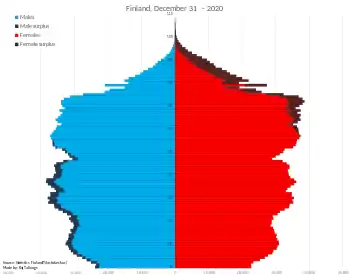 Population pyramid of Finland in 2020 | |
| Population | 5,587,841 |
| Growth rate | 0.24% (2022 est.) |
| Birth rate | 8.9 births/1,000 population (2021) |
| Death rate | 10.4 deaths/1,000 population (2021) |
| Life expectancy | 81.76 years |
| • male | 78.86 years |
| • female | 84.79 years (2022 est.) |
| Fertility rate | 1.32 children born/woman (2022)[1] |
| Infant mortality rate | 2.13 deaths/1,000 live births |
| Net migration rate | 2.35 migrant(s)/1,000 population (2022 est.) |
| Age structure | |
| 0–14 years | 15.4% (2021) |
| 15–64 years | 61.6% (2021) |
| 65 and over | 23.1% (2021) |
| Sex ratio | |
| Total | 0.97 male(s)/female (2022 est.) |
| At birth | 1.05 male(s)/female |
| Under 15 | 1.05 male(s)/female |
| 65 and over | 0.63 male(s)/female |
| Nationality | |
| Nationality | Finn |
| Major ethnic | Finnish (90.9% background) |
| Language | |
| Official | Finnish, Swedish |
| Spoken | Finnish, Swedish, Sámi |
Finland is a predominantly ethnically homogeneous country with a dominant ethnicity of Finnish descent. However, there are notable minority groups in the form of Finland-Swedes, Sámi, and Roma people, with important historical significance. The official languages are Finnish and Swedish, with the latter being the mother tongue of roughly 5.2% of the Finnish populace. Finland was a part of the Swedish kingdom for around 500 years.[3]
Due to recent immigration, significant populations of ethnic Estonians, Russians, Iraqis, Chinese and Somalis now reside in the country. Furthermore, by 2023, Ukrainians had become the second-largest ethnic group in the region, following closely behind the Estonian population.[4][5]
As of 2022, Statistics Finland publishes data on the foreign population using three distinct methodologies. The Finnish population includes persons of foreign origin and background, who make up 9.1% of the total population.[note 1] In additional calculations, the proportion of persons born outside Finland is 8.6%. Individuals who have a first language other than Finnish, Swedish or Sámi account for 8.9%.[3]
In the history of Finland, the first human settlement originated approximately 11,000 BC, following the end of the Ice Age.[7] The initial settlers of present-day Finland were presumably hunter-gatherers. They were later replaced by the Sámi, followed by Finnic populations from the east, south and west. The initial dependable population information dates back to 1749 when Swedish officials initially recorded population statistics. Finland was a part of the Swedish Kingdom until it became an autonomous state within the Russian Empire in 1809, and finally gained independence in 1917.
In the late 19th and 20th centuries, significant emigration, primarily from rural areas, occurred to Sweden and North America, while Finland's primary immigrant source was other European countries. Approximately 300,000 Finnish nationals reside abroad and, according to estimates, the number of individuals of Finnish ancestry worldwide ranges from 1.6 to 2 million. Currently, Sweden, the United Kingdom, Germany, the United States, and Spain are the preferred destinations for most Finnish emigrates.[8]
One of the primary challenges facing society in the future is adapting to demographic changes, particularly the aging of the population. The proportion of the working-age population is decreasing, resulting in projected labour shortages.[9] However, immigration has significantly increased in recent years. If the current trend persists, the population of Finland will continue to increase and could even reach the milestone of 6 million people by 2040.[10]
Population
As of 2022, there is an 5,563,970 people in Finland.[3]
Demographic statistics according to the World Population Review in 2022.[11]
- One birth every 11 minutes
- One death every 9 minutes
- One net migrant every 38 minutes
- Net gain of one person every 120 minutes
Historical population
The first human settlement in Finland originated around 11,000 BC, following the end of the Ice Age. The initial inhabitants of modern-day Finland were presumably hunter-gatherers. There is no information about the language spoken by the first inhabitants. However, it is known that the Finnish and Sámi languages emerged thousands of years later.[7] Archaeological, linguistic, and genetic studies support the notion that the country was inhabited from south to north, with a population of a few thousand during prehistoric times. The Sámi people then succeeded the previous inhabitants, followed by the influx of Finnic people from the east, west, and south who eventually replaced them. Currently, the Sámi people number around 10,000 in Finland as a minority. Although they have lived north of the Arctic Circle for 7,000 years, they make up only 5% of the population of the province of Lapland.
The reliable population data is available from 1749, when Sweden first compiled population statistics. At that time, the population of Finland stood at 410,400 individuals. The threshold of one million inhabitants was surpassed subsequent to the Finnish War (1808-1809) in 1811, upon the annexation of the Old Finland region. The milestone of five million inhabitants was reached in 1991.[12]
Exceeding the million population milestones:[12]
- million in 1811
- million in 1879
- million in 1912
- million in 1950
- million in 1991
Until the beginning of the 20th century, annual population growth fluctuated between 1% and 2%. There were a few exceptional years of negative growth during times of war and destruction.[12] The significant demographic and economic transformations that took place in Finland post-World War II impacted the composition of Finnish families. Over time, family sizes reduced noticeably, declining from an average of 3.6 individuals in 1950 to an average of 2.7 in 1975. Despite this change, family structures remained relatively constant during the 25-year period, with 24.4% of families consisting of a man and a woman, 61.9% comprising a couple and children, 11.8% consisting of a woman with offspring, and 1.9% consisting of a man with offspring. There were no substantial differences in percentages compared to 1950.[13]
Nonetheless, fewer children were born per family; the average decreased from 2.24 in 1950 to 1.7 in the 1980s. Large families were infrequent, with only 2% having four or more children, while 51% had a single child; 38% had two children, and 9% had three children.[13] Population growth declined to below 0.5% in the 1970s, and to approximately 0.2% in the 1990s. In recent years, however, population growth has recovered partially, rising to approximately 0.5%, partly due to increased immigration.[12]
|
|
| |||||||||||||||||||||||||||||||||||||||||||||||||||||||||||||||||||||||||||||||||||||||||||||
| Population size prior to 1812 may be affected by changes on administrative divisions. 1990-2020 source: Statistics Finland[3] | |||||||||||||||||||||||||||||||||||||||||||||||||||||||||||||||||||||||||||||||||||||||||||||||
Distribution and density
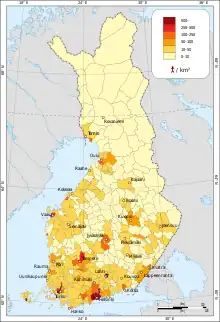
As of 2022, the population density of Finland was 18.3 persons per square kilometre. The region of Uusimaa was the most densely populated region with around 190 persons per square kilometre, while Lapland was the least densely populated region with only around two persons per square kilometre.[2] The populace is heavily clustered in the west and south of Finland, where the largest urban centres are situated.[14] There are a total of nine cities in Finland with more than 100,000 residents.[9]
| Population by region as of 2022[2] | |||||||||||||||||
|---|---|---|---|---|---|---|---|---|---|---|---|---|---|---|---|---|---|
| Area | Population | Of total population (%) | |||||||||||||||
| Uusimaa | 1,733,033 | 31 | |||||||||||||||
| Southwest Finland | 485,567 | 9 | |||||||||||||||
| Satakunta | 212,556 | 4 | |||||||||||||||
| Kanta-Häme | 169,537 | 3 | |||||||||||||||
| Pirkanmaa | 532,671 | 10 | |||||||||||||||
| Päijät-Häme | 204,528 | 4 | |||||||||||||||
| Kymenlaakso | 159,488 | 3 | |||||||||||||||
| South Karelia | 125,353 | 2 | |||||||||||||||
| South Savo | 130,451 | 2 | |||||||||||||||
| North Savo | 247,689 | 4 | |||||||||||||||
| North Karelia | 162,540 | 3 | |||||||||||||||
| Central Finland | 272,437 | 5 | |||||||||||||||
| South Ostrobothnia | 190,774 | 3 | |||||||||||||||
| Ostrobothnia | 176,323 | 3 | |||||||||||||||
| Central Ostrobothnia | 67,805 | 1 | |||||||||||||||
| North Ostrobothnia | 416,543 | 7 | |||||||||||||||
| Kainuu | 70,521 | 1 | |||||||||||||||
| Lapland | 175,795 | 3 | |||||||||||||||
| Åland | 30,359 | 1 | |||||||||||||||
The geographical center of population (Weber point) of the Finnish population is currently located in Hauho, in the village of Sappee, now part of the town of Hämeenlinna. The coordinates of this point are 61' 17" N, 25' 07" E.[15]
| Area | Population | Of total population (%) | |
|---|---|---|---|
| URBAN AREAS | 4,044,568 | 73 | |
| Inner urban area | 2,104,164 | 38 | |
| Outer urban area | 1,341,122 | 24 | |
| Peri-urban area | 599,282 | 11 | |
| RURAL AREAS | 1,450,534 | 26 | |
| Local centres in rural areas | 302,264 | 5 | |
| Rural areas close to urban areas | 385,211 | 7 | |
| Rural heartland areas | 503,590 | 9 | |
| Sparsely populated rural areas | 259,469 | 5 | |
| Unknown | 68,868 | 1 | |
Fertility
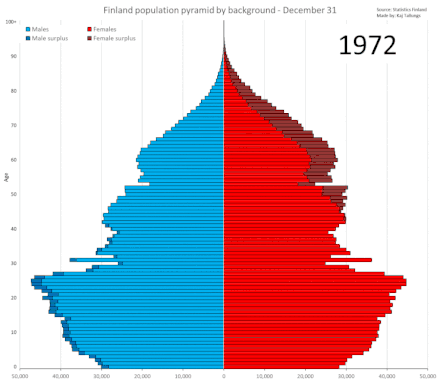
As of 2022, the birth rate dropped to its lowest level on record since 1776 with a total fertility rate of 1.32. A total of 44,951 children were born, and 38,179 (85%) of them were delivered by women who speak Finnish, Swedish or Sámi, the country's national languages.[1] As of 2020, the average age of first-time mothers was 29.7 years old. The mean age of women who have given birth to a live child was 31.3 years.[16]
| Total fertility rate and gross reproduction rate by region as of 2022[17] | ||
|---|---|---|
| Area | Total fertility rate | Gross reproduction rate |
| FINLAND | 1.32 | 0.64 |
| Uusimaa | 1.26 | 0.61 |
| Southwest Finland | 1.27 | 0.62 |
| Satakunta | 1.40 | 0.68 |
| Kanta-Häme | 1.42 | 0.67 |
| Pirkanmaa | 1.23 | 0.61 |
| Päijät-Häme | 1.36 | 0.66 |
| Kymenlaakso | 1.23 | 0.58 |
| South Karelia | 1.28 | 0.61 |
| South Savo | 1.29 | 0.6 |
| North Savo | 1.30 | 0.65 |
| North Karelia | 1.19 | 0.57 |
| Central Finland | 1.28 | 0.64 |
| South Ostrobothnia | 1.57 | 0.78 |
| Ostrobothnia | 1.57 | 0.78 |
| Central Ostrobothnia | 1.73 | 0.83 |
| North Ostrobothnia | 1.58 | 0.78 |
| Kainuu | 1.37 | 0.67 |
| Lapland | 1.34 | 0.66 |
| Åland | 1.45 | 0.85 |
As of 2021, people with a foreign background in Finland had higher fertility rates than those with Finnish roots. Women of foreign descent, either born abroad (1.7) or in Finland (1.65), had the most substantial total fertility rates, averaging 1.45 for all women in Finland. Women of Finnish lineage had a slightly higher fertility rate of 1.4. For men, the total fertility rate was just above 1.3, with Finnish men slightly under the average. In contrast, men of foreign origin, whether born abroad or in Finland, exhibited a fertility rate of approximately 1.45 each. Since 2018, the most frequent countries of affiliation for women of foreign origin delivering infants have been former Soviet Union countries, Somalia, and Iraq.[18]
Historical fertility rates
In the 18th century, Finland recorded a fertility rate of 5-6 children per woman, but population growth was hindered by high infant mortality, with approximately 1 in 5 infants dying before their first birthday. Fertility remained relatively steady in the 19th century, with occasional variations. During times of conflict, such as the Finnish war, and periods of famine, birth rates declined, but eventually normalised. Presently, some developing countries have fertility rates similar to those of Finland in the 18th and 19th centuries.[19]
As the 19th century drew to a close, the traditional agrarian society began to crumble. Simultaneously, the industrial and service sectors witnessed a surge in job opportunities, and urban migration intensified. Manufacturing plants mushroomed in proximity to rivers. Fewer children being born played a role in the rising living standards. However, it is important to note that contraceptive methods were limited to the rhythm method and interrupted intercourse.[19]
| Total fertility rate (TFR) in Finland from 1776 to 1899 | |||||||||||||||||
|---|---|---|---|---|---|---|---|---|---|---|---|---|---|---|---|---|---|
| Years[20] | |||||||||||||||||
| 1776 | 1777 | 1778 | 1779 | 1780 | 1781 | 1782 | 1783 | 1784 | 1785 | 1786 | 1787 | 1788 | 1789 | 1790 | 1791 | 1792 | 1793 |
| 5.42 | 5.51 | 5.82 | 5.91 | 5.71 | 5.17 | 5.74 | 5.42 | 5.79 | 5.39 | 5.6 | 5.46 | 4.86 | 4.51 | 4.88 | 4.66 | 5.43 | 5.71 |
| 1794 | 1795 | 1796 | 1797 | 1798 | 1799 | 1800 | 1801 | 1802 | 1803 | 1804 | 1805 | 1806 | 1807 | 1808 | 1809 | 1810 | 1811 |
| 5.41 | 5.18 | 5.05 | 5.2 | 5.08 | 5.09 | 4.92 | 5.07 | 5.23 | 4.78 | 5.24 | 5.21 | 4.84 | 4.97 | 4.16 | 3.69 | 5.1 | 4.66 |
| 1812 | 1813 | 1814 | 1815 | 1816 | 1817 | 1818 | 1819 | 1820 | 1821 | 1822 | 1823 | 1824 | 1825 | 1826 | 1827 | 1828 | 1829 |
| 4.95 | 4.6 | 4.72 | 4.84 | 4.82 | 4.84 | 4.78 | 4.51 | 4.55 | 5.34 | 4.59 | 5.21 | 4.84 | 4.83 | 4.89 | 4.77 | 5.12 | 4.98 |
| 1830 | 1831 | 1832 | 1833 | 1834 | 1835 | 1836 | 1837 | 1838 | 1839 | 1840 | 1841 | 1842 | 1843 | 1844 | 1845 | 1846 | 1847 |
| 4.85 | 4.58 | 4.47 | 3.96 | 4.75 | 4.57 | 4.17 | 4.17 | 4.32 | 4.47 | 4.59 | 4.56 | 4.96 | 4.77 | 4.64 | 4.76 | 4.39 | 4.46 |
| 1848 | 1849 | 1850 | 1851 | 1852 | 1853 | 1854 | 1855 | 1856 | 1857 | 1858 | 1859 | 1860 | 1861 | 1862 | 1863 | 1864 | 1865 |
| 4.84 | 4.92 | 4.78 | 5.17 | 4.79 | 4.8 | 5.02 | 4.82 | 4.86 | 4.48 | 4.87 | 4.74 | 4.84 | 5.2 | 5.03 | 4.85 | 5.28 | 4.79 |
| 1866 | 1867 | 1868 | 1869 | 1870 | 1871 | 1872 | 1873 | 1874 | 1875 | 1876 | 1877 | 1878 | 1879 | 1880 | 1881 | 1882 | 1883 |
| 4.46 | 4.47 | 3.4 | 4.52 | 4.86 | 4.95 | 4.87 | 4.97 | 5.12 | 4.95 | 4.97 | 5.19 | 4.81 | 5.14 | 5.01 | 4.79 | 4.99 | 4.96 |
| 1884 | 1885 | 1886 | 1887 | 1888 | 1889 | 1890 | 1891 | 1892 | 1893 | 1894 | 1895 | 1896 | 1897 | 1898 | 1899 | ||
| 5.04 | 4.79 | 4.98 | 5.17 | 5.07 | 4.89 | 4.83 | 5.04 | 4.65 | 4.43 | 4.59 | 4.87 | 4.8 | 4.77 | 5.07 | 4.96 | ||
The decline in fertility experienced a noteworthy acceleration in the early 20th century. In 1900, the fertility rate stood at 4.8, which plummeted to 2.3 by 1933. In the late 1930s, fertility rates experienced an uptick, but it later plummeted due to the war, particularly in 1940 as a result of the Winter War. Although the ceasefire caused a spike in births, the resumption of hostilities stalled family planning efforts. Post-war in autumn 1944, there was a resurgence in births, leading to a total fertility rate of 3.1 in 1945, reaching a peak of 3.5 in 1947-1948, a record that remains unbroken. However, fertility rates began a steady decline, dipping below the generational renewal threshold of 2.1 by 1969. Finnish fertility rates have not recovered to this level since.[19]
The decline persisted until 1973, when it hit a historic low of 1.5 children per woman. In recent years, there have been fluctuations, with fertility rates fluctuating between 1.7 and 1.9.[19] As of the 2020s, Finland's overall fertility rate has fallen below 1.4.[17]
| Total fertility rate (TFR) in Finland from 1900 to 2022 | |||||||||||||||||
|---|---|---|---|---|---|---|---|---|---|---|---|---|---|---|---|---|---|
| Years[17] | |||||||||||||||||
| 1900 | 1901 | 1902 | 1903 | 1904 | 1905 | 1906 | 1907 | 1908 | 1909 | 1910 | 1911 | 1912 | 1913 | 1914 | 1915 | 1916 | 1917 |
| 4.83 | 4.92 | 4.79 | 4.62 | 4.85 | 4.67 | 4.81 | 4.76 | 4.65 | 4.72 | 4.60 | 4.46 | 4.45 | 4.15 | 4.13 | 3.89 | 3.69 | 3.71 |
| 1918 | 1919 | 1920 | 1921 | 1922 | 1923 | 1924 | 1925 | 1926 | 1927 | 1928 | 1929 | 1930 | 1931 | 1932 | 1933 | 1934 | 1935 |
| 3.60 | 2.87 | 3.76 | 3.58 | 3.43 | 3.44 | 3.22 | 3.17 | 3.02 | 2.92 | 2.92 | 2.83 | 2.75 | 2.59 | 2.46 | 2.27 | 2.33 | 2.37 |
| 1936 | 1937 | 1938 | 1939 | 1940 | 1941 | 1942 | 1943 | 1944 | 1945 | 1946 | 1947 | 1948 | 1949 | 1950 | 1951 | 1952 | 1953 |
| 2.31 | 2.52 | 2.52 | 2.56 | 2.15 | 2.90 | 2.00 | 2.46 | 2.56 | 3.07 | 3.41 | 3.47 | 3.47 | 3.33 | 3.16 | 3.01 | 3.06 | 2.96 |
| 1954 | 1955 | 1956 | 1957 | 1958 | 1959 | 1960 | 1961 | 1962 | 1963 | 1964 | 1965 | 1966 | 1967 | 1968 | 1969 | 1970 | 1971 |
| 2.93 | 2.93 | 2.91 | 2.86 | 2.68 | 2.75 | 2.71 | 2.65 | 2.66 | 2.66 | 2.58 | 2.46 | 2.41 | 2.32 | 2.15 | 1.94 | 1.83 | 1.70 |
| 1972 | 1973 | 1974 | 1975 | 1976 | 1977 | 1978 | 1979 | 1980 | 1981 | 1982 | 1983 | 1984 | 1985 | 1986 | 1987 | 1988 | 1989 |
| 1.59 | 1.50 | 1.62 | 1.69 | 1.72 | 1.69 | 1.65 | 1.64 | 1.63 | 1.65 | 1.72 | 1.74 | 1.70 | 1.64 | 1.60 | 1.59 | 1.70 | 1.71 |
| 1990 | 1991 | 1992 | 1993 | 1994 | 1995 | 1996 | 1997 | 1998 | 1999 | 2000 | 2001 | 2002 | 2003 | 2004 | 2005 | 2006 | 2007 |
| 1.78 | 1.79 | 1.85 | 1.81 | 1.85 | 1.81 | 1.76 | 1.75 | 1.70 | 1.73 | 1.73 | 1.73 | 1.72 | 1.76 | 1.80 | 1.80 | 1.84 | 1.83 |
| 2008 | 2009 | 2010 | 2011 | 2012 | 2013 | 2014 | 2015 | 2016 | 2017 | 2018 | 2019 | 2020 | 2021 | 2022 | |||
| 1.85 | 1.86 | 1.87 | 1.83 | 1.80 | 1.75 | 1.71 | 1.65 | 1.57 | 1.49 | 1.41 | 1.35 | 1.37 | 1.46 | 1.32 | |||
The fertility rate in Finland exceeded that of neighbouring countries for the duration of the 20th century. However, since 2010, there has been a significant decline, whereas other Nordic countries have not experienced such a trend until more recently. It is a recent development that Sweden and Finland have similar social policies and incomes, however, Finland is the only country experiencing natural population decrease (excluding immigration).[21]
Age
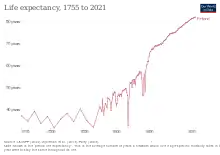
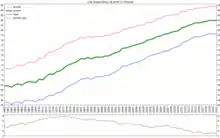
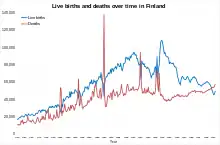

The Finnish population is ageing. Life expectancy has also increased in recent decades. Population growth has mainly been driven by immigration. Furthermore, the population is increasingly concentrated in urban areas in southern and western Finland.
- As of 2022, the average age of the Finnish population was 43.7 years, with an average age of 42.4 years for men and 45.0 years for women.[22]
- As of 2020, the average age of death for men was 75.3 and 82.1 for women, indicating a margin of 6.9 years.[23]
- As of 2022, infant mortality was very low in Finland. There were two deaths per thousand live births, with 2.3 deaths per thousand for male infants and 1.8 deaths per thousand for female infants.[24]
| Age structure as of 2022[22] | |||
|---|---|---|---|
| Age | Population | Of total population (%) | |
| Under 4 | 238,282 | 4.3 | |
| 5 - 9 | 285,852 | 5.1 | |
| 10 - 14 | 316,194 | 5.7 | |
| 15 - 19 | 307,960 | 5.5 | |
| 20 - 24 | 304,385 | 5.5 | |
| 25 - 29 | 344,950 | 6.2 | |
| 30 - 34 | 372,101 | 6.7 | |
| 35 - 39 | 363,619 | 6.5 | |
| 40 - 44 | 356,657 | 6.4 | |
| 45 - 49 | 334,702 | 6.0 | |
| 50 - 54 | 326,045 | 5.9 | |
| 55 - 59 | 364009 | 6.5 | |
| 60 - 64 | 354,703 | 6.4 | |
| 65 - 69 | 349,928 | 6.3 | |
| 70 - 74 | 343,733 | 6.2 | |
| 75 - 79 | 273,662 | 4.9 | |
| 80 - 84 | 168,074 | 3.0 | |
| Over 85 | 159,114 | 2.9 | |
Life extectancy and mortality
In the mid-18th century, when population statistics were initially recorded, Finland recorded an annual death rate of over 10,000, with yearly fluctuations. The overall mortality rate was at 26 and men had a life expectancy of 36.1 years during the 1750s, while women had an expectancy of 38.4 years. The gender gap in life expectancy was a few years at that time.[25]
The rapid spread of various infectious diseases such as cholera caused mortality up until the 1870s. The war years significantly increased mortality rates in the civilian population. During this time, the highest mortality rates were recorded during the Finnish War of 1808-09 and the cholera outbreak of 1832-33, which caused the deaths of a significant portion of the population. The years 1867-68 were marked as years of high death rates, with the latter year seeing a peak of 137,700 deaths.[25]
| Life expectancy in Finland from 1755 to 1899 | |||||||||||||||||
|---|---|---|---|---|---|---|---|---|---|---|---|---|---|---|---|---|---|
| Years[26] | |||||||||||||||||
| 1755 | 1765 | 1775 | 1785 | 1795 | 1805 | 1815 | 1825 | 1835 | 1845 | 1855 | 1865 | 1875 | 1878 | 1879 | 1880 | 1881 | 1882 |
| 37.3 | 34.9 | 39.4 | 33.8 | 37.1 | 31.8 | 35.8 | 38.4 | 34.7 | 40.5 | 35.1 | 32.1 | 41.6 | 39.2 | 44.9 | 39.6 | 37.6 | 40.4 |
| 1883 | 1884 | 1885 | 1886 | 1887 | 1888 | 1889 | 1890 | 1891 | 1892 | 1893 | 1894 | 1895 | 1896 | 1897 | 1898 | 1899 | |
| 42.7 | 42.8 | 41.3 | 40.8 | 45.5 | 45.1 | 44.9 | 44.6 | 42.5 | 39.7 | 43.3 | 45.2 | 47.6 | 46.5 | 48.1 | 48.0 | 44.3 | |
Before the turn of the 20th century, mortality rates were notably high, but they gradually decreased thereafter. During that time period, the life expectancy of a newborn saw a significant increase to 42.8 years for men and 45.7 years for women. The gender gap in life expectancy already stood at three years. Starting from the beginning of the 20th century, improvements in hygiene, prevention of communicable diseases, and advancements in vaccinations and medicines played crucial roles in accelerating the decline in mortality rates, as compared to previous decades. On the eve of World War II, life expectancy for males stood at 53.4 years and for females, 59.0 years, constituting a five-year gap between them.[25] The life expectancy took almost two centuries to increase by 20 years since the 18th century. In contrast, the succeeding two decades only required 40 years to attain the same growth by the mid-20th century.[25]
| Life expectancy in Finland from 1900 to 1950 | |||||||||||||||||
|---|---|---|---|---|---|---|---|---|---|---|---|---|---|---|---|---|---|
| Years[26] | |||||||||||||||||
| 1900 | 1901 | 1902 | 1903 | 1904 | 1905 | 1906 | 1907 | 1908 | 1909 | 1910 | 1911 | 1912 | 1913 | 1914 | 1915 | 1916 | 1917 |
| 41.7 | 42.8 | 46.2 | 46.6 | 47.2 | 46.0 | 47.0 | 46.7 | 46.1 | 48.6 | 48.5 | 48.7 | 49.1 | 49.0 | 49.7 | 49.5 | 48.0 | 46.5 |
| 1918 | 1919 | 1920 | 1921 | 1922 | 1923 | 1924 | 1925 | 1926 | 1927 | 1928 | 1929 | 1930 | 1931 | 1932 | 1933 | 1934 | 1935 |
| 32.8 | 43.1 | 47.5 | 52.4 | 51.9 | 52.5 | 50.2 | 53.4 | 53.8 | 51.8 | 53.7 | 51.3 | 54.5 | 54.9 | 55.8 | 55.4 | 56.0 | 54.4 |
| 1936 | 1937 | 1938 | 1939 | 1940 | 1941 | 1942 | 1943 | 1944 | 1945 | 1946 | 1947 | 1948 | 1949 | 1950 | |||
| 56.2 | 57.1 | 57.2 | 54.6 | 46.6 | 46.5 | 54.0 | 56.3 | 48.0 | 57.2 | 60.2 | 60.5 | 62.0 | 61.9 | 64.2 | |||
| Life expectancy in Finland from 1971 to 2022 | |||||||||||||||||
|---|---|---|---|---|---|---|---|---|---|---|---|---|---|---|---|---|---|
| Years[24] | |||||||||||||||||
| 1971 | 1972 | 1973 | 1974 | 1975 | 1976 | 1977 | 1978 | 1979 | 1980 | 1981 | 1982 | 1983 | 1984 | 1985 | 1986 | 1987 | 1988 |
| 70,1 | 70,8 | 71,3 | 71,2 | 71,7 | 72,0 | 72,5 | 73,3 | 73,3 | 73,6 | 73,9 | 74,5 | 74,4 | 74,7 | 74,4 | 74,7 | 74,8 | 74,8 |
| 1989 | 1990 | 1991 | 1992 | 1993 | 1994 | 1995 | 1996 | 1997 | 1998 | 1999 | 2000 | 2001 | 2002 | 2003 | 2004 | 2005 | 2006 |
| 75,0 | 75,0 | 75,4 | 75,6 | 75,9 | 76,6 | 76,6 | 76,9 | 77,1 | 77,3 | 77,5 | 77,7 | 78,1 | 78,3 | 78,5 | 78,8 | 79,0 | 79,4 |
| 2007 | 2008 | 2009 | 2010 | 2011 | 2012 | 2013 | 2014 | 2015 | 2016 | 2017 | 2018 | 2019 | 2020 | 2021 | 2022* | ||
| 79,4 | 79,7 | 79,8 | 80,0 | 80,4 | 80,5 | 80,9 | 81,1 | 81,4 | 81,3 | 81,5 | 81,6 | 81,9 | 81,8 | 81,8 | 81,2 | ||
Vital statistics
Data from Statistics Finland, which is the official agency for the collection of statistics in Finland.[27]
Vital statistics 1900-2022 | |||||||||||||||||||||||||||||||||||||||||||||||||||||||||||||||||||||||||||||||||||||||||||||||||||||||||||||||||||||||||||||||||||||||||||||||||||||||||||||||||||||||||||||||||||||||||||||||||||||||||||||||||||||||||||||||||||||||||||||||||||||||||||||||||||||||||||||||||||||||||||||||||||||||||||||||||||||||||||||||||||||||||||||||||||||||||||||||||||||||||||||||||||||||||||||||||||||||||||||||||||||||||||||||||||||||||||||||||||||||||||||||||||||||||||||||||||||||||||||||||||||||||||||||||||||||||||||||||||||||||||||||||||||||||||||||||||||||||||||||||||||||||||||||||||||||||||||||||||||||||||||||||||||||||||||||||||||||||||||||||||||||||||||||||||||||||||||||||||||||||||||||||||||||||||||||||||||||||||||||||||||||||||||||||||||||||||||||||||||||||||||||||||||||||||||||||||||||||||||||||||||||||||||||||||||||||||||||||||||||||||||||||||||||||||||||||||||||||||||||||||||||||||||||||||||||||||||||||||||||||||||||||||||||||||||||||||||||||||||||||||||||||||||||||||||||||||||||||||||||
|---|---|---|---|---|---|---|---|---|---|---|---|---|---|---|---|---|---|---|---|---|---|---|---|---|---|---|---|---|---|---|---|---|---|---|---|---|---|---|---|---|---|---|---|---|---|---|---|---|---|---|---|---|---|---|---|---|---|---|---|---|---|---|---|---|---|---|---|---|---|---|---|---|---|---|---|---|---|---|---|---|---|---|---|---|---|---|---|---|---|---|---|---|---|---|---|---|---|---|---|---|---|---|---|---|---|---|---|---|---|---|---|---|---|---|---|---|---|---|---|---|---|---|---|---|---|---|---|---|---|---|---|---|---|---|---|---|---|---|---|---|---|---|---|---|---|---|---|---|---|---|---|---|---|---|---|---|---|---|---|---|---|---|---|---|---|---|---|---|---|---|---|---|---|---|---|---|---|---|---|---|---|---|---|---|---|---|---|---|---|---|---|---|---|---|---|---|---|---|---|---|---|---|---|---|---|---|---|---|---|---|---|---|---|---|---|---|---|---|---|---|---|---|---|---|---|---|---|---|---|---|---|---|---|---|---|---|---|---|---|---|---|---|---|---|---|---|---|---|---|---|---|---|---|---|---|---|---|---|---|---|---|---|---|---|---|---|---|---|---|---|---|---|---|---|---|---|---|---|---|---|---|---|---|---|---|---|---|---|---|---|---|---|---|---|---|---|---|---|---|---|---|---|---|---|---|---|---|---|---|---|---|---|---|---|---|---|---|---|---|---|---|---|---|---|---|---|---|---|---|---|---|---|---|---|---|---|---|---|---|---|---|---|---|---|---|---|---|---|---|---|---|---|---|---|---|---|---|---|---|---|---|---|---|---|---|---|---|---|---|---|---|---|---|---|---|---|---|---|---|---|---|---|---|---|---|---|---|---|---|---|---|---|---|---|---|---|---|---|---|---|---|---|---|---|---|---|---|---|---|---|---|---|---|---|---|---|---|---|---|---|---|---|---|---|---|---|---|---|---|---|---|---|---|---|---|---|---|---|---|---|---|---|---|---|---|---|---|---|---|---|---|---|---|---|---|---|---|---|---|---|---|---|---|---|---|---|---|---|---|---|---|---|---|---|---|---|---|---|---|---|---|---|---|---|---|---|---|---|---|---|---|---|---|---|---|---|---|---|---|---|---|---|---|---|---|---|---|---|---|---|---|---|---|---|---|---|---|---|---|---|---|---|---|---|---|---|---|---|---|---|---|---|---|---|---|---|---|---|---|---|---|---|---|---|---|---|---|---|---|---|---|---|---|---|---|---|---|---|---|---|---|---|---|---|---|---|---|---|---|---|---|---|---|---|---|---|---|---|---|---|---|---|---|---|---|---|---|---|---|---|---|---|---|---|---|---|---|---|---|---|---|---|---|---|---|---|---|---|---|---|---|---|---|---|---|---|---|---|---|---|---|---|---|---|---|---|---|---|---|---|---|---|---|---|---|---|---|---|---|---|---|---|---|---|---|---|---|---|---|---|---|---|---|---|---|---|---|---|---|---|---|---|---|---|---|---|---|---|---|---|---|---|---|---|---|---|---|---|---|---|---|---|---|---|---|---|---|---|---|---|---|---|---|---|---|---|---|---|---|---|---|---|---|---|---|---|---|---|---|---|---|---|---|---|---|---|---|---|---|---|---|---|---|---|---|---|---|---|---|---|---|---|---|---|---|---|---|---|---|---|---|---|---|---|---|---|---|---|---|---|---|---|---|---|---|---|---|---|---|---|---|---|---|---|---|---|---|---|---|---|---|---|---|---|---|---|---|---|---|---|---|---|---|---|---|---|---|---|---|---|---|---|---|---|---|---|---|---|---|---|---|---|---|---|---|---|---|---|---|---|---|---|---|---|---|---|---|---|---|---|---|---|---|---|---|---|---|---|---|---|---|---|---|---|---|---|---|---|---|---|---|---|---|---|---|---|---|---|---|---|---|---|---|---|---|---|---|---|---|---|---|---|---|---|---|---|---|---|---|---|---|---|---|---|---|---|---|---|---|---|---|---|---|---|---|---|---|---|---|---|---|---|---|---|---|---|---|---|---|---|---|---|---|---|---|---|---|---|---|---|---|---|---|---|---|---|---|---|---|---|---|---|---|---|---|---|---|---|---|---|---|---|---|---|---|---|---|---|---|---|---|---|---|---|---|---|---|---|---|---|---|---|---|---|---|---|---|---|---|---|---|---|---|---|---|---|---|---|---|---|---|---|---|---|---|---|---|---|---|---|---|---|---|---|---|---|---|---|---|---|---|---|---|---|---|---|---|---|---|
|
Languages
Official and national languages
.svg.png.webp)
Finland has two official languages (national languages): Finnish and Swedish. In addition, there are other languages that are officially recognised by the authorities, but are not national languages. The Sámi languages are those of Finland's indigenous people. Indigenous languages with a long history in Finland include Finnish Romani (Kalo), Finnish Sign Language, Finnish-Swedish Sign Language and Karelian. Finnish, which belongs to the Uralic languages, is spoken by approximately 4.9 million people in Finland as a first language and by more than 0.5 million as a second language. It's also spoken in Sweden, Norway, Eastern Karelia, Ingria (Russia), the USA and Australia, with various dialects. Written Finnish dates back 500 years.[29]
Swedish, an Indo-European language within the North Germanic branch, is spoken by approximately 9 million people worldwide, including 296,000 speakers in Finland. Finland Swedish is a regional variety that aims to remain similar to the Swedish spoken in Sweden. The Sámi languages, which are indigenous to Europe and closely related to the Finnic languages, have approximately 60,000-100,000 speakers, of whom 10,000 live in Finland. There are three Sámi languages in Finland: Inari Sámi, Skolt Sámi and Northern Sámi, each with its own written form. Since 1992 they have had official status in certain areas of Lapland.[29]
Karelian, spoken in Finland and Russia, is the closest linguistic relative of Finnish. There are fewer than 100,000 speakers of Karelian, with approximately 5,000 in Finland. Romani, an Indo-European language, belongs to the Indo-Aryan subgroup of the Indo-Iranian branch. Finnish Romani is one of the Northern Romani dialects and has been spoken in Finland for approximately 450 years. Efforts to preserve it as a literary language began in the 1970s. Finnish Sign Language serves as the primary language for 4,000-5,000 deaf Finns and is used as a first or second language by 6,000-9,000 hearing Finns. Finnish-Swedish Sign Language, on the other hand, is endangered, with only 90 users left.[29]
All mainland municipalities are monolingual in Finnish or bilingual in Finnish and Swedish. None is monolingual Swedish. However, Swedish is the only official language on the autonomous island of Åland.[30]
First languages of the foreign population
Population by mother tongue (2022)[3]
As of 2022, 495,992 people, or 8.9%, live in Finland with a first language other than Finnish, Swedish or Sámi.[3] More than 150 foreign languages are spoken in Finland.[29] However, most of them have only few speakers. Historically, Finland has been a bilingual country where only Finnish or Swedish was spoken. This is slowly changing as the rate of immigration has increased in last three decades.[31] The majority of the Finnish population is able to communicate in English. However, the foreign population is expected to study and speak Finnish or Swedish if they want to integrate into Finnish society.[32]
As of 2022, the most common foreign languages are Russian (1.7%), Estonian (0.9%), Arabic (0.7%) and English (0.5%).[3] Approximately 70% of the country's foreign speakers live in Finland's six largest cities.[33]
Population of Finland according to mother tongue (excluding Åland) 1990–2020 | |||||||||||||||||||||||||||||||||||||||||||||||||||||||||||||||||||||||||||||||||||||||||||||||||||||||||||||||||||||||||||||||||||||||||||||||||||||||||||||||||||||||||||||||||||||||||||||||||||||||||||||||||||||||||||||||||||||||||||||||||||||||||||||||||||||||||||||||||||||||||||||||||||||||||||||||||||||||||||||||||||||||||||||||||||||||||||||||||||||||||||||||||||||||||||||||||||||||||||||||||||||||||||||||||||||||||||||||||||||||||||||||||||||||||||||||||||||||||||||||||||||||||||||||||||||||||||||||||||||||||||||||||||||
|---|---|---|---|---|---|---|---|---|---|---|---|---|---|---|---|---|---|---|---|---|---|---|---|---|---|---|---|---|---|---|---|---|---|---|---|---|---|---|---|---|---|---|---|---|---|---|---|---|---|---|---|---|---|---|---|---|---|---|---|---|---|---|---|---|---|---|---|---|---|---|---|---|---|---|---|---|---|---|---|---|---|---|---|---|---|---|---|---|---|---|---|---|---|---|---|---|---|---|---|---|---|---|---|---|---|---|---|---|---|---|---|---|---|---|---|---|---|---|---|---|---|---|---|---|---|---|---|---|---|---|---|---|---|---|---|---|---|---|---|---|---|---|---|---|---|---|---|---|---|---|---|---|---|---|---|---|---|---|---|---|---|---|---|---|---|---|---|---|---|---|---|---|---|---|---|---|---|---|---|---|---|---|---|---|---|---|---|---|---|---|---|---|---|---|---|---|---|---|---|---|---|---|---|---|---|---|---|---|---|---|---|---|---|---|---|---|---|---|---|---|---|---|---|---|---|---|---|---|---|---|---|---|---|---|---|---|---|---|---|---|---|---|---|---|---|---|---|---|---|---|---|---|---|---|---|---|---|---|---|---|---|---|---|---|---|---|---|---|---|---|---|---|---|---|---|---|---|---|---|---|---|---|---|---|---|---|---|---|---|---|---|---|---|---|---|---|---|---|---|---|---|---|---|---|---|---|---|---|---|---|---|---|---|---|---|---|---|---|---|---|---|---|---|---|---|---|---|---|---|---|---|---|---|---|---|---|---|---|---|---|---|---|---|---|---|---|---|---|---|---|---|---|---|---|---|---|---|---|---|---|---|---|---|---|---|---|---|---|---|---|---|---|---|---|---|---|---|---|---|---|---|---|---|---|---|---|---|---|---|---|---|---|---|---|---|---|---|---|---|---|---|---|---|---|---|---|---|---|---|---|---|---|---|---|---|---|---|---|---|---|---|---|---|---|---|---|---|---|---|---|---|---|---|---|---|---|---|---|---|---|---|---|---|---|---|---|---|---|---|---|---|---|---|---|---|---|---|---|---|---|---|---|---|---|---|---|---|---|---|---|---|---|---|---|---|---|---|---|---|---|---|---|---|---|---|---|---|---|---|---|---|---|---|---|---|---|---|---|---|---|---|---|---|---|---|---|---|---|---|---|---|---|---|---|---|---|---|---|---|---|---|---|---|---|---|---|---|---|---|---|---|---|---|
| |||||||||||||||||||||||||||||||||||||||||||||||||||||||||||||||||||||||||||||||||||||||||||||||||||||||||||||||||||||||||||||||||||||||||||||||||||||||||||||||||||||||||||||||||||||||||||||||||||||||||||||||||||||||||||||||||||||||||||||||||||||||||||||||||||||||||||||||||||||||||||||||||||||||||||||||||||||||||||||||||||||||||||||||||||||||||||||||||||||||||||||||||||||||||||||||||||||||||||||||||||||||||||||||||||||||||||||||||||||||||||||||||||||||||||||||||||||||||||||||||||||||||||||||||||||||||||||||||||||||||||||||||||||
Immigration
Statistics of foreign population
As of 2022, Statistics Finland produces statistics on foreign nationals in three different ways:[3]
- Origin and background country: 507,173 people or 9.1%, have a foreign background.
- Country of birth: 476,857 people, or 8.6 %, were born in a foreign country.
- Language: 495,992 people, or 8.9%, have a first language other than Finnish, Swedish or Sámi.
No official statistics exist on ethnicities. Nonetheless, the Finnish population statistics are available according to the birth countries of the residents' parents (foreign background/origin statistics). International census recommendations define an ethnic group by the perception of its members of historical, regional, or national origin. Therefore, data on ethnic status should always be sourced from a person's own statement. Due to the fact that Finland's census is registry-based, official statistics regarding ethnic groups cannot be provided.[39]
Origin and background country
Origin and background country - the definition used by Statistics Finland includes all individuals with at least one parent born in Finland as being of Finnish background. Individuals with both parents or only one known parent born abroad are classified as having foreign heritage. If both parents of an individual were born abroad, the mother's country of birth is primarily considered as the background country. For all individuals of Finnish heritage, the background country is Finland.[40][note 2]
Origin and background country of population in Finland by continent 1990–2020 | ||||||||||||||||||||||||||||||||||||||||||||||||||||||||||||||||||||||||||||||||||||||||||||||||||||||||||||||||||||||||||||||||||||||||||||||||||||||
|---|---|---|---|---|---|---|---|---|---|---|---|---|---|---|---|---|---|---|---|---|---|---|---|---|---|---|---|---|---|---|---|---|---|---|---|---|---|---|---|---|---|---|---|---|---|---|---|---|---|---|---|---|---|---|---|---|---|---|---|---|---|---|---|---|---|---|---|---|---|---|---|---|---|---|---|---|---|---|---|---|---|---|---|---|---|---|---|---|---|---|---|---|---|---|---|---|---|---|---|---|---|---|---|---|---|---|---|---|---|---|---|---|---|---|---|---|---|---|---|---|---|---|---|---|---|---|---|---|---|---|---|---|---|---|---|---|---|---|---|---|---|---|---|---|---|---|---|---|---|---|
| ||||||||||||||||||||||||||||||||||||||||||||||||||||||||||||||||||||||||||||||||||||||||||||||||||||||||||||||||||||||||||||||||||||||||||||||||||||||
Country of birth
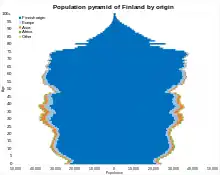
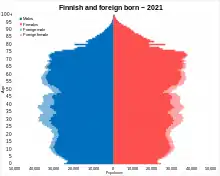

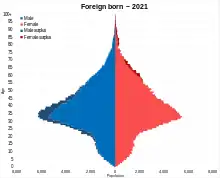

The definition used by Statistics Finland for country of birth is based on the mother's country of permanent residence at the time of birth. Consequently, Estonian immigrants born before Estonian independence are recorded as being born in the Soviet Union, and those born in territories ceded by Finland are listed as being born in Finland, regardless of subsequent territorial changes. This information reflects the government in power at the time of birth and is devoid of subjective evaluations.[43]
| Country of birth (2022)[3] | Population | % |
|---|---|---|
| 5,087,113 | 91.4% | |
| 63,885 | 1.1% | |
| 47,198 | 0.8% | |
| 33,902 | 0.6% | |
| 21,725 | 0.4% | |
| 20,499 | 0.4% | |
| 14,493 | 0.3% | |
| 13,171 | 0.2% | |
| 12,452 | 0.2% | |
| 11,634 | 0.2% | |
| 10,873 | 0.2% | |
| 10,117 | 0.2% | |
| 9,800 | 0.2% | |
| 9,269 | 0.2% | |
| 9,269 | 0.2% | |
| 9,164 | 0.2% | |
| 8,271 | 0.1% | |
| 7,728 | 0.1% | |
| 7,455 | 0.1% | |
| 6,535 | 0.1% | |
| 5,465 | 0.1% | |
| 5,367 | 0.1% | |
| 5,039 | 0.1% | |
| 4,994 | 0.1% | |
| 4,761 | 0.1% | |
| 4,726 | 0.1% | |
| 3,826 | 0.1% | |
| 3,279 | 0.1% | |
| 3,540 | 0.1% | |
| 3,495 | 0.1% | |
| 3,208 | 0.1% | |
| 3,134 | 0.1% | |
| 2,891 | 0.1% |
Emigration

Historically, Finnish emigration began in the 16th century, when Finns worked in Swedish mines, and continued until the 1970s. About 100,000 Finns emigrated to Russia during the Tsarist period, mainly to St Petersburg. Large-scale emigration began in the late 19th century, with about 400,000 Finns moving to the United States and Canada by 1980. After the Second World War, many Finns emigrated to Sweden, reaching a peak in 1970 when 41,000 settled there. An estimated 250,000 to 300,000 Finns became permanent residents of Sweden after the war. However, migration slowed in the 1980s, with more Finns returning than leaving.[13]
The impact of emigration on the Finnish labour force and birth rate has been significant. Finland has experienced two major waves of emigration: one at the beginning of the 20th century, when more than 300,000 Finns went to North America, and another from the 1950s to the 1970s, when 400,000 Finns moved to Sweden, forming large expatriate communities.[44]
Apart from these major flows, there have been smaller migrations around the world and some Finns live in different countries. In the 21st century about 14,000 people, mostly of Finnish origin, emigrate every year. Many are well-educated and may return to Finland after a few years. About 300,000 Finnish citizens live abroad and it's estimated that about 1.5 million people of Finnish origin live overseas.[44]
Internal migration
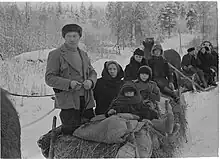
Migration has played an important role in shaping Finnish society throughout its history. Notable instances comprise of the Forest Finns' migration to Sweden during the 15th century and the relocation of Ingrians to the present-day St Petersburg region during the 17th century. Changes in borders resulted in the formation of Finnish settlements outside its territory. Wars and political conflicts led to massive population movements, such as the Karelian evacuation during World War II, which exiled roughly 420,000 individuals within Finland's borders.[45]
Until the 1960s, Finland was predominantly an agricultural society. However, waves of urbanization and political transitions have contributed to migration movements. Currently, urbanization continues to be a significant internal migration pattern, with growth centers and sparsely populated regions. Approximately 250,000 people, mainly young adults, make annual municipal moves, which have notable implications for regional development in the 21st century.[45]
Religion
Before Christianisation, Finnish paganism prevailed, venerating deities such as Ukko, the god of thunder and sky. Currently, most of the Finnish population consider themselves nominal Christians, though the proportion of non-religious individuals has increased since the 1980s. As of 2022, 65.2% of the population were affiliated with the Evangelical Lutheran Church, 1.0% with the Orthodox Church and 1.8% were members of another religious group. A total of 32.0% have no religious affiliation.[22] The Evangelical Lutheran Church and the Orthodox Church are both entitled to collect church tax. There are around 140 registered religious communities, including Islam, Catholicism, and Jehovah's Witnesses.[47]
In Finland, there are also revival movements, which began as spiritual reform movements and are now organized and active within the Evangelical Lutheran Church of Finland. The historic Finnish revivalist movements emerged in the late 1700s and 1800s and consisted of the Prayer Movement, the Awakened Movement, the Lutheran Evangelical Movement, and the Laestadian Movement. These movements laid out an important religious and social influence on Finnish society during this period.[48]
Religious freedom is highly valued in Finland and all residents have the right to choose and practice their faith.[47] Religious education is mandatory in Finnish schools, customized to a student's registered denomination if there are a minimum of three pupils who profess that religion.[49]
Education
The Finnish educational framework encompasses several developmental phases, from early childhood through pre-primary, primary, and lower secondary (basic education), to gymnasium (lukio), vocational, higher, and adult education. Compulsory education is mandatory for 6 to 18-year-olds, covering pre-primary to upper secondary levels.[50]
Upon completion of the nine-year basic education, students may opt between gymnasium, culminating in a matriculation exam, or vocational upper secondary, culminating in a vocational qualification. Higher education in Finland comprises universities and universities of applied sciences, which place emphasis on education and research. While universities are authorized to grant doctorates, universities of applied sciences offer vocational education and practical research.[50]
In 2012 OECD survey, adults aged 16 to 65 in Finland exhibit exceptional literacy, numeracy, and problem-solving skills in technology compared to other countries surveyed. Young adults aged 16-24 have above-average literacy, whereas those aged 55-65 perform at an average level, resulting in a massive 37-point age-related gap. In contrast, foreign-language immigrants in Finland demonstrate lower literacy proficiency than native Finns, consistent with the international average.[51]
Low literacy is correlated with poor health, with individuals reporting low literacy being twice as likely to experience health problems. Furthermore, in Finland, individuals with advanced skill sets have a significantly higher likelihood of being employed when compared to those with lower skill sets, with a difference of almost double.[51]
Notes
- Statistics Finland classifies a person as having a "foreign background" if both parents or the only known parent were born abroad.[6]
- In 2012, Statistics Finland implemented a classification system for determining origin and background comparable to that employed by other Nordic countries. This system utilizes data on parental birthplaces to differentiate between Finnish natives and foreign-born individuals. It is important to note that data regarding individuals who passed before 1964 is unavailable in the Population Information System. Approximately 900,000 Finnish-born residents, whose parental birthplaces are unknown due to the pre-system death of their parents, are categorized as Finnish given that their native language is either Finnish, Swedish, or Sámi. Individuals with at least one parent born in Finland are classified as having a Finnish background. For those with foreign-born parents or missing parental data, a foreign background is assigned, regardless of whether they were born in Finland or abroad. In cases where both parents were born abroad, the mother's birthplace takes precedence in determining the background. If only the father's birthplace is known, it is used to determine the background. If the parental data and foreign background of a person born in Finland are unknown, their birthplace is considered their background. However, if someone is born in Finland with unknown parental information and foreign background deduction, their background remains unknown. In the case of internationally adopted children by Finnish-born parents, they are treated as having a Finnish background, with Finland as their birth country.[41]
- In fertility rates, 2.1 and above is a stable population and has been marked blue, 2 and below leads to an aging population and the result is that the population decreases.
References
- "Total fertility rate lowest in measuring history in 2022". Statistics Finland. 21 April 2023. Retrieved 17 September 2023.
- "Population structure 2000-2022, urban-rural classification". Statistics Finland. 26 May 2023. Retrieved 29 September 2023.
- "Number of foreign-language speakers grew by nearly 38,000 persons". Statistics Finland. 31 May 2023. Retrieved 12 September 2023.
- "Population 31.12. by Region, Background country, Sex, Age, Origin, Year and Information". PxWeb. Archived from the original on 31 March 2023. Retrieved 6 October 2023.
- "Population 31.12. by Region, Background country, Sex, Age, Origin, Year and Information". PxWeb. Archived from the original on 6 October 2023. Retrieved 6 October 2023.
- "Persons with foreign background". Statistics Finland. Retrieved 18 September 2023.
- "Ensimmäisillä suomalaisilla oli käytössään aikakautensa kehittynyttä teknologiaa: näin Suomi asutettiin jääkauden jälkeen" (in Finnish). Helsingin Sanomat. 17 May 2021. Retrieved 3 October 2023.
- "Expatriate Finns are united by their Finnish identity". Ministry of the Interior. Retrieved 29 September 2023.
- "Eurydice: 1. Political, social and economic background and trends: 1.3 Population: demographic situation, languages and religions". European Commission. 16 June 2022. Retrieved 2 October 2023.
- "Kuusi miljoonaa suomalaista vuonna 2040 – totta vai tarua?" (in Finnish). Satakunnan kansa. 20 September 2023. Retrieved 2 October 2023.
- "Finland Population 2018", World Population Review, archived from the original on 17 February 2021, retrieved 27 July 2018
- "Väestötieteen perusteet - 12.1 Suomen väestö kautta aikojen" (in Finnish). Statistics Finland. Retrieved 1 October 2023.
- Text from PD source: US Library of Congress: A Country Study: Finland Archived 14 February 2015 at the Wayback Machine, Library of Congress Call Number DL1012 .A74 1990.
- "Facts about Finland" (PDF). Ministry for Foreign Affairs in 2015. 2015. Retrieved 1 October 2023.
- Matka väestölliseen keskipisteeseen, Helsingin Sanomat, 30 July 2012, p. A5. Online edition Archived 5 February 2019 at the Wayback Machine
- "Decrease in birth rate stopped in 2020". Statistics Finland. 23 April 2021. Retrieved 2 October 2023.
- "Birth rate". Statistics Finland. Retrieved 2 October 2023.
- "More Babies of Foreign Background Born in Finland in 2021 Than of Finnish Roots, Statistics Show". schengenvisainfo.com. 13 December 2022. Archived from the original on 24 March 2023. Retrieved 19 February 2023.
- "Väestötieteen perusteet - 12.2 Hedelmällisyyden kehitys – lapsiluku pienenee" (in Finnish). Statistics Finland. Retrieved 1 October 2023.
- Max Roser (2014), "Total Fertility Rate around the world over the last centuries", Our World In Data, Gapminder Foundation, archived from the original on 5 February 2019, retrieved 7 August 2018
- Bauer, Elizabeth (1 October 2019). "Why Has Finland's Fertility Rate Collapsed – And Are There Lessons For Us?". Forbes. Archived from the original on 20 September 2020. Retrieved 21 September 2020.
- "Population structure". Statistics Finland. Retrieved 1 October 2023.
- "Number of deaths increased from the previous year". Statistics Finland. 23 April 2021. Retrieved 3 October 2023.
- "Deaths". Statistics Finland. Retrieved 3 October 2023.
- "Väestötieteen perusteet - 12.3 Kuolevuuden kehitys – elinaikaa lisää" (in Finnish). Statistics Finland. Retrieved 1 October 2023.
- "Life expectancy". Our World in Data. Archived from the original on 29 August 2018. Retrieved 28 August 2018.
- "Statistics Finland". Archived from the original on 23 September 2020. Retrieved 12 February 2011."List of Tables in English". Archived from the original on 24 February 2021. Retrieved 27 May 2017.
- Soviet-Finnish War
- "Languages of Finland". The Institute for the Languages of Finland. Retrieved 4 October 2023.
- "The special status of the Åland Islands". Ministry for Foreign Affairs. Retrieved 4 October 2023.
- "Number of immigrations nearly 50,000 in 2022". Statistics Finland. 24 May 2023. Retrieved 4 October 2023.
- "Fluent Finnish required". Familia. Retrieved 4 October 2023.
- "Suomen suurimmat kaupungit haluavat keskustella maahanmuutosta suoraan pääministerin kanssa – sanovat maksavansa itse nyt kaiken" (in Finnish). Yle. 13 March 2023. Retrieved 5 October 2023.
- Population of mainland Finland (excluding Åland) according to language, 1990–2015 Archived 6 January 2013 at archive.today Statistics Finland
- "Finland in Statistics: 2016" (PDF). Archived (PDF) from the original on 14 February 2019. Retrieved 19 February 2020.
- "Finland in Statistics: 2019" (PDF). Archived (PDF) from the original on 25 February 2021. Retrieved 19 February 2020.
- "Finland in Statistics: 2020" (PDF). Archived (PDF) from the original on 19 July 2020. Retrieved 9 October 2020.
- "Population". Archived from the original on 23 December 2020. Retrieved 10 September 2021.
- Nieminen, Jari (2013). "Etnisyystiedon merkitys kasvaa maahanmuuton lisääntyessä". Tilastokeskus (in Finnish). Statistics Finland. Archived from the original on 30 August 2014. Retrieved 21 January 2017.
- Tilastokeskus. "Statistics Finland". stat.fi. Archived from the original on 14 April 2023. Retrieved 14 April 2023.
- "Origin and background country - definition 1". Statistics Finland. 31 May 2023. Retrieved 5 October 2023.
- "PxWeb - Select table". pxdata.stat.fi. Archived from the original on 14 April 2023. Retrieved 14 April 2023.
- "Country of birth - definition 1". Statistics Finland. 31 May 2023. Retrieved 5 October 2023.
- "Emigration". The Migration Institute of Finland. Retrieved 6 October 2023.
- "Internal Migration". The Migration Institute of Finland. Retrieved 6 October 2023.
- "Belonging to a religious community by age and sex, 2000-2022". Tilastokeskuksen PX-Web tietokannat. Government. Archived from the original on 31 May 2023. Retrieved 31 May 2023. Note these are official state religious registration numbers, people may be registered yet not practicing/believing and they may be believing/practicing but not registered.
- "Cultures and religions in Finland". InfoFinland.fi. 24 October 2022. Retrieved 6 October 2023.
- "Revival movements". The Church Research Institute. Retrieved 6 October 2023.
- "Religious Education in Finland". Suomen uskonnonopettajain liitto ry. Retrieved 6 October 2023.
- "Finnish education system". Finnish National Agency for Education. 24 October 2022. Retrieved 6 October 2023.
- "FINLAND – Country Note –Survey of Adult Skills first results" (PDF). OECD. Retrieved 6 October 2023.